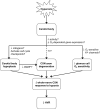Chronic hyperoxia and the development of the carotid body
- PMID: 22640932
- PMCID: PMC3448014
- DOI: 10.1016/j.resp.2012.05.019
Chronic hyperoxia and the development of the carotid body
Abstract
Preterm infants often experience hyperoxia while receiving supplemental oxygen. Prolonged exposure to hyperoxia during development is associated with pathologies such as bronchopulmonary dysplasia and retinopathy of prematurity. Over the last 25 years, however, experiments with animal models have revealed that moderate exposures to hyperoxia (e.g., 30-60% O(2) for days to weeks) can also have profound effects on the developing respiratory control system that may lead to hypoventilation and diminished responses to acute hypoxia. This plasticity, which is generally inducible only during critical periods of development, has a complex time course that includes both transient and permanent respiratory deficits. Although the molecular mechanisms of hyperoxia-induced plasticity are only beginning to be elucidated, it is clear that many of the respiratory effects are linked to abnormal morphological and functional development of the carotid body, the principal site of arterial O(2) chemoreception for respiratory control. Specifically, developmental hyperoxia reduces carotid body size, decreases the number of chemoafferent neurons, and (at least transiently) diminishes the O(2) sensitivity of individual carotid body glomus cells. Recent evidence suggests that hyperoxia may also directly or indirectly impact development of the central neural control of breathing. Collectively, these findings emphasize the vulnerability of the developing respiratory control system to environmental perturbations.
Copyright © 2012 Elsevier B.V. All rights reserved.
Figures





Similar articles
-
Combined effects of intermittent hyperoxia and intermittent hypercapnic hypoxia on respiratory control in neonatal rats.Respir Physiol Neurobiol. 2019 Feb;260:70-81. doi: 10.1016/j.resp.2018.11.002. Epub 2018 Nov 12. Respir Physiol Neurobiol. 2019. PMID: 30439529 Free PMC article.
-
Effects of Perinatal Hyperoxia on Breathing.Compr Physiol. 2020 Mar 12;10(2):597-636. doi: 10.1002/cphy.c190023. Compr Physiol. 2020. PMID: 32163205 Review.
-
Chronic intermittent hyperoxia alters the development of the hypoxic ventilatory response in neonatal rats.Respir Physiol Neurobiol. 2016 Jan;220:69-80. doi: 10.1016/j.resp.2015.09.015. Epub 2015 Oct 9. Respir Physiol Neurobiol. 2016. PMID: 26444750 Free PMC article.
-
Ventilatory and chemoreceptor responses to hypercapnia in neonatal rats chronically exposed to moderate hyperoxia.Respir Physiol Neurobiol. 2017 Mar;237:22-34. doi: 10.1016/j.resp.2016.12.008. Epub 2016 Dec 26. Respir Physiol Neurobiol. 2017. PMID: 28034711 Free PMC article.
-
Developmental plasticity of the hypoxic ventilatory response after perinatal hyperoxia and hypoxia.Respir Physiol Neurobiol. 2005 Nov 15;149(1-3):287-99. doi: 10.1016/j.resp.2005.04.003. Respir Physiol Neurobiol. 2005. PMID: 16203217 Review.
Cited by
-
Carotid chemoreceptor "resetting" revisited.Respir Physiol Neurobiol. 2013 Jan 1;185(1):30-43. doi: 10.1016/j.resp.2012.09.002. Epub 2012 Sep 13. Respir Physiol Neurobiol. 2013. PMID: 22982216 Free PMC article. Review.
-
The relationship between intermittent hypoxemia events and neural outcomes in neonates.Exp Neurol. 2021 Aug;342:113753. doi: 10.1016/j.expneurol.2021.113753. Epub 2021 May 10. Exp Neurol. 2021. PMID: 33984336 Free PMC article. Review.
-
Role of TrkB during the postnatal development of the rat carotid body.Respir Physiol Neurobiol. 2015 Dec;219:18-24. doi: 10.1016/j.resp.2015.07.010. Epub 2015 Jul 26. Respir Physiol Neurobiol. 2015. PMID: 26222433 Free PMC article.
-
Combined effects of intermittent hyperoxia and intermittent hypercapnic hypoxia on respiratory control in neonatal rats.Respir Physiol Neurobiol. 2019 Feb;260:70-81. doi: 10.1016/j.resp.2018.11.002. Epub 2018 Nov 12. Respir Physiol Neurobiol. 2019. PMID: 30439529 Free PMC article.
-
Structural Plasticity of the Carotid Body.Adv Anat Embryol Cell Biol. 2023;237:37-48. doi: 10.1007/978-3-031-44757-0_4. Adv Anat Embryol Cell Biol. 2023. PMID: 37946076
References
-
- Bavis RW. Developmental plasticity of the hypoxic ventilatory response after perinatal hyperoxia and hypoxia. Respir. Physiol. Neurobiol. 2005;149:287–299. - PubMed
-
- Bavis RW, Mitchell GS. Long-term effects of the perinatal environment on respiratory control. J. Appl. Physiol. 2008;104:1220–1229. - PubMed
-
- Bavis RW, Olson EB, Jr., Mitchell GS. Critical developmental period for hyperoxia-induced blunting of hypoxic phrenic responses in rats. J. Appl. Physiol. 2002;92:1013–1018. - PubMed
Publication types
MeSH terms
Grants and funding
LinkOut - more resources
Full Text Sources
Other Literature Sources

